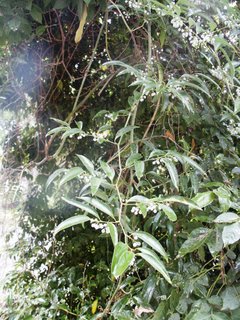
Morning Glory is thick as kudzu, reaching up into the sweetgum tree, twining around the rose bush, and covering the daylilies with a blanket of its heart shaped leaves. I have let my garden get away from me once again. Chaos reigns.
I think of leveling the whole mess and starting over, but decide against it. The morning glory flowers are dazzling on cool, September mornings, and I know there is not much to see beneath them.
Dozens of other interlopers have shown up around my garden, thanks to my inattention. Volunteer hackberry, wisteria, smilax, and Carolina cherry are the primary invaders. Elegant eleagnus bursts through on occasion as well.
Hole Number 9 at Augusta National is named Carolina Cherry, so it can’t be such a disreputable shrub, though Prunus caroliniana, is an opportunistic plant that tends to pop up whenever it can. With shiny, simple, alternate, evergreen leaves, it has black fruit that birds love to eat. The bark is gray-brown and smooth on young stems, becoming grooved and scaly on older stems. Carolina cherry is respectable enough to be sold as a landscaping tree, claiming kinship to other cherry laurels, such as Otto Luyken. It’s shade tolerant and can make a good border shrub.
Hackberries are tolerant of a variety of soils and climate conditions. For those reasons, you can see them popping up through the most well-manicured and densely planted borders. Its pale green, diaphanous leaves make an airy canopy above the warty trunk. I suppose a golfer would shy away from a hole called “Hackberry,” but the berries of these trees are a favorite of birds and a host of insects, such as the hackberry woolly aphid that develops on the leaves. The sticky “honeydew” from this insect rains heavy onto whatever sits beneath it, and if the object happens to be your car, you’ll want to do some serious pruning or resign to giving your car a daily bath.
The sound of Bill Peterson's old truck alerts me that he has arrived to take down the blasted tree, after years of suffering through sticky windshields and sooty leaf drop. Its loss will mean our thicket a little less thick, but our cars are a little more clean.
There are somewhere between 200 and 300 species of smilax vines, several of which can be found on the edges of my garden. The thorny catbrier has a pale, droopy leaf and we could surely do without it. But the handsome, smooth stemmed lanceolata always shows its glossy evergreen leaves best at Christmas when we can adorn our doorways and mantles with the stuff, just like our great grandmothers did before the days of twinkling lights and vinyl pine swags.
Virginia Creeper has taken a strong hold around my garden as well. This vine, with its leaves made up of five pointed leaflets, can be useful in covering a wall or fence, but it can be invasive. It is handsome in the fall when its leaves turn ruby red.
I read suggestions every year about planting marigolds now instead of mums, since the flowers will last longer and they’ll put on a better show. The suggestions hasn’t leaked to the garden centers, however, and the choices for adding color to the faded flower beds seem limited to mums and asters. It’s too soon to plant pansies, since we’ll have more warm days, so I spend an hour pulling up the weeds near the back door, fertilize the roses one more time, hunker down and wait for a freeze to do the rest of the cleaning for me.



